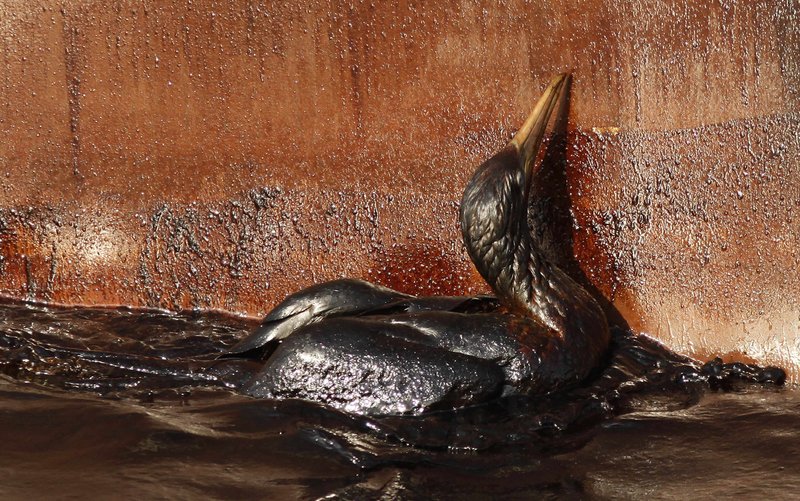WASHINGTON — With a quick solution ominously uncertain, the oil spill in the Gulf of Mexico is on track to become an unprecedented economic and environmental disaster with millions of gallons of oil destroying an ecosystem as well as a way of life.
BP America said Monday that it would take another 75 days to finish one of two relief wells it’s drilling to shut down the flow. then, if the spill doesn’t worsen and the relief well stops the leak, some 20 million gallons of oil will be swirling in the Gulf, nearly double the Exxon Valdez spill in 1989.
Unlike the Alaska spill, which coated a rock-strewn bay, BP’s oil will cling to a spongelike coast, entering the pores of mangrove forests and sea-grass beds and the breeding grounds for crabs, shrimp and oysters.
Already some of the richest fishing grounds of the Gulf are off-limits, idling thousands of commercial fishermen. Some restaurants in New Orleans and elsewhere are either out of homegrown oysters or are down to less than a week’s supply.
In Mississippi, charter boats and hotels are reporting declines in business.
“It’s going to be unbelievably bad,” said Jeremy Jackson, a professor of oceanography at the Scripps Institution of Oceanography in La Jolla, Calif. “This is a problem that won’t go away for a decade.”.
Ryan LaFontaine, a spokesman for the city of Gulfport, Miss., said Gulf leaders were in almost constant contact with federal and BP officials, including a daily conference call with people at the White House. LaFontaine said these were just “daily updates,” however. Besides putting out booms, which everyone agrees won’t work in anything but the lightest chop in shallow water, LaFontaine said no one seemed to have much advice.
“The best protection right now, aside from booms and underwater fencing or everybody linking hands along the beach and trying to blow the oil back out, is to get this thing shut off,” LaFontaine said.
Further, whatever happens in the Gulf could spread.
Scientists say they can’t predict more than a few days in advance where the oil is heading. If it slips into the powerful Loop Current, it could spread toward South Florida, get picked up by the Gulf Stream and head up the East Coast before it turns at Cape Hatteras, N.C., toward the open sea.
That could prove disastrous for Florida’s enormous tourism industry, with 80 million visitors drawn yearly to its pristine beaches.
A growing slick could cut into a commercial fishing industry that produced about 1.27 billion pounds of fish and shellfish in 2008 with a dockside value of more than $659 million, according to the Gulf of Mexico Fishery Management Council.
Beyond that, more than 3.2 million people fish for fun in the Gulf each year.
Damage to the wetlands could cost society billions of dollars in lost natural filtration of water and protection of property from storm surges. The coastal areas also are important habitat for birds, shrimp and many other forms of life.
Meanwhile, thousands of workers kept up efforts to hold the spill back from land: spraying chemical dispersants, skimming, laying booms and burning oil on the surface.
Jackson, however, thinks it’s highly likely the oil will hit, and that’s something he saw up close once before. He was in charge of the Smithsonian Tropical Research Institute in Panama in 1986 when a tank ruptured at a refinery, dumping oil on the Caribbean coast.
“What we learned was never, ever let oil get into a mangrove coast. You’ll never get it out. It’s like a sponge you rub on a greasy bacon pan. You need very hot water and a lot of soap, and you still might just give up and throw away the sponge.”
The Gulf’s coastal sea-grass beds and mangroves are full of burrowing animals that make millions of holes. Oil works its way out of the holes eventually and then storms flush it back into the water, creating what amounts to a new spill.
Sen. Bill Nelson, D-Fla., an opponent of offshore drilling, said it would be his “worst nightmare” if the oil flowed for nearly three months more until the relief well was complete. “It’s going to cover up the Gulf Coast and the wind is eventually going to keep it going south, and it’s going to get into the Loop Current, and the Loop Current comes south and comes through the Florida Keys, where 85 percent of the live coral reefs in the country are,” Nelson said.
Keith Overton, the chief operating officer of TradeWinds Island Resorts, told the Senate Environment and Public Works Committee on Tuesday that Florida’s $57 billion tourism industry was its biggest employer, with 900,000 workers.
Overton said that the weak economy and unseasonably cold winter had made the industry fragile, and “I fear the affects of this oil spill will be devastating and similar to those Florida’s tourism industry experienced after the multiple hurricanes of 2004.”
Another concern is the possibility that the spill will get much worse. If the wellhead gave way entirely, the amount of oil would increase greatly, said Larry McKinney, the executive director of the Harte Research Institute for Gulf of Mexico Studies at Texas A&M University at Corpus Christi.
Send questions/comments to the editors.



Success. Please wait for the page to reload. If the page does not reload within 5 seconds, please refresh the page.
Enter your email and password to access comments.
Hi, to comment on stories you must . This profile is in addition to your subscription and website login.
Already have a commenting profile? .
Invalid username/password.
Please check your email to confirm and complete your registration.
Only subscribers are eligible to post comments. Please subscribe or login first for digital access. Here’s why.
Use the form below to reset your password. When you've submitted your account email, we will send an email with a reset code.